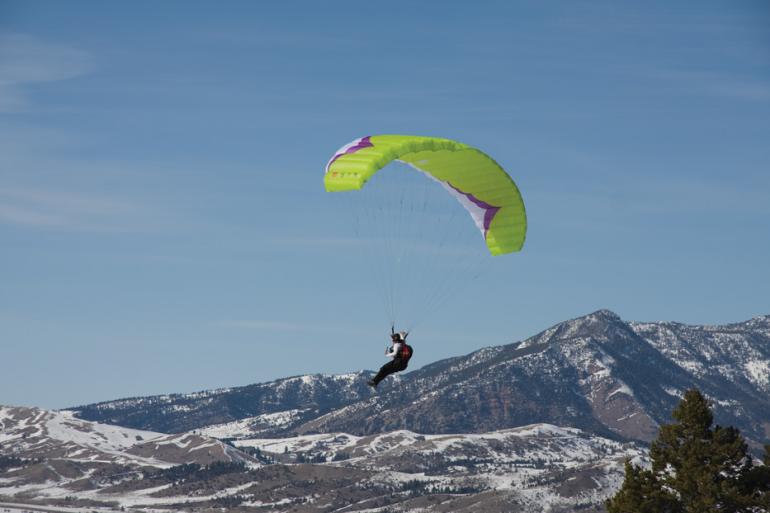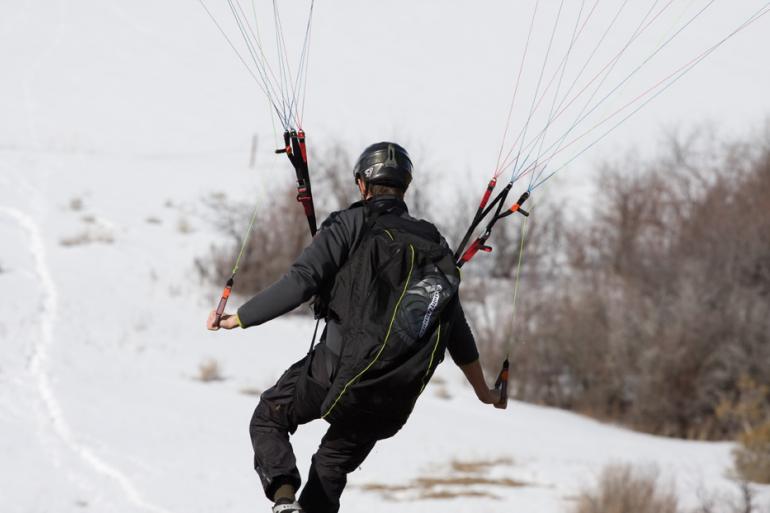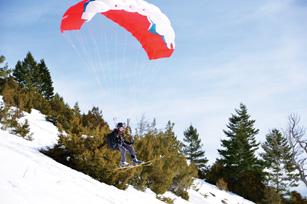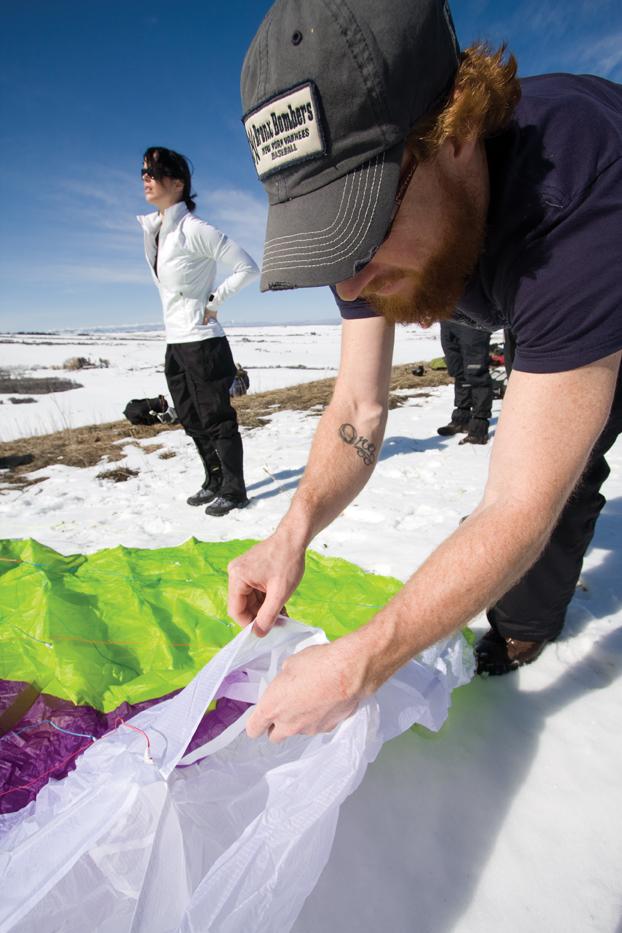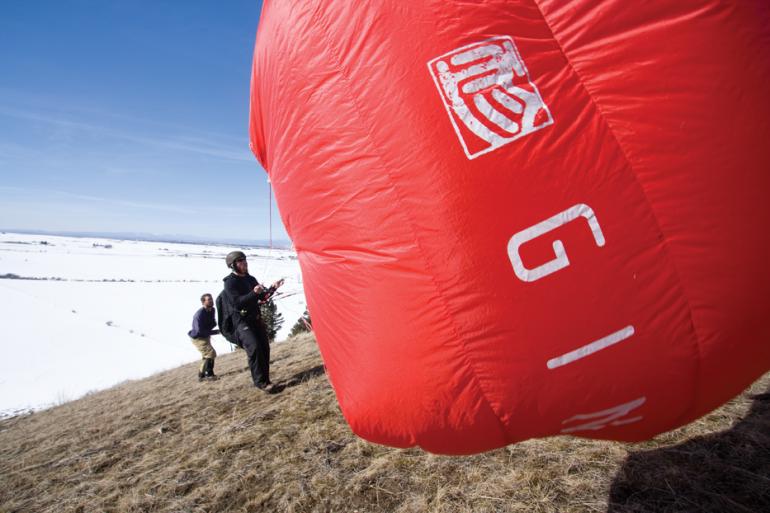Wings on the Wind
With the blinding sun streaming through my frosted windshield, I drove toward the M trailhead early on a cold morning. Just to be prepared, nearly every piece of skiing equipment I owned was packed into the trunk of my car: two pairs of skis, touring boots, helmet, skins, avy gear, hiking boots, gaiters, big pack, and a small pack. As I rolled into the parking lot, there were a few other heavily-geared folks loitering already. “You waiting for Andy?” I asked.
On this icy January morning, half a dozen strangers were scheduled to partake in a sport they’d never done. In fact, most of us signed up for Bozeman Paragliding’s three-day speedflying course before we had any idea what speedflying even was. Speed was generally good. The word flying sounded incredible. But most of us had never put the two together.
The online videos were stunning—confident people perched at the tops of wintry mountains, clicking into downhill boards with small parachutes spread on the snow behind them. Then: action! A few strides forward and the parachute was up, inflated. Young, virile people soaring in swooping arcs over the cliffs and powder beneath them. Then flying close, so close to the terrain they could play with the trees and rocks. Skimming the snow. Touching down quick, then slicing back into the air. Fast, smooth landings. Hooting and high-fives all around.
Who wouldn’t want to do that?
Eventually, there were six of us anxious for Andy. When he finally pulled into the parking lot, the first order of business was paperwork: over five pages of “inherent risks” and “immanent dangers!” It was exciting, even writing out the “I may die” paragraph by hand on page four.
Once Andy’s liability was covered, we were ready to fly. Even though the M is one of the “best places to speedfly in the state of Montana,” according to our guide, he decided to start us off on the practice hill at the entrance to Bear Canyon—the access to which was through private property with no actual parking. We divided up our copious gear into as few vehicles as possible and headed south through town.
On the ride over, Andy cleared up one thing for us right away: it was a “wing” we’d be using, a “speedflying wing,” not a parachute. Don’t ever call it a parachute.
Once we lumbered to the top of the hill, Andy did surprisingly little “safety” speechmaking. We all watched as he unpacked and spread out two wings, the fabric resembling faded paper maché, then said, “Who’s ready?”
I sure as hell wasn’t. But Huntley was. When asked if he’d done this before, he said, “Nope, but it seems pretty simple.” Andy replied, “These first few flights are pretty simple. Easy, really, as long as you don’t do anything.” Right. Just don’t do anything. Good advice.
Huntley took a few deep breaths and Andy said, “Go!” through the radio strapped to Huntley’s chest. He charged down the hill, his boots tossing clumps of snow until the wing pulled him into the air. As he floated back towards the ground, Andy shouted, “Brake! Brake! Brake!” Huntley yanked hard on the cords, pulled them clear to his knees, pendulumed neatly, and settled into the snow.
If he could do it…
Jaron volunteered to go next. While he geared up, Andy explained that speedflying was a relatively new sport, only four or five years old. It had been conceived by paragliders who enjoyed the first and last moments of a flight the most—when they were closest to the ground. They’d shrunk the paragliding wing, making it lighter and faster so they could enjoy that close-to-the-ground feeling for the whole flight. Then others picked up the new wing design and added downhill ski gear to really bump up the fun factor.
That’s what all the videos online had shown, and I was still holding onto the “ski launch” idea. A few of us asked Andy if he thought we could get on some snow farther down the hill. He said “Sure,” and added, “I doubt you’ll get off the ground starting from here, but it’s nice to feel how the wing works.” He knew we were too chicken for the real deal.
By the time it was my turn to give it a go, there had been two fairly intense collisions with large sagebrushes that dotted the run. Thankfully, Andy pointed out a clean line and gave me a tip as I clipped into my skis: “Once you get going, just tap the brakes a little if you can’t avoid a bush. It’ll pop you a few feet off the ground.” Okay, tap the brakes. Right.
It seemed Andy was parceling out advice at a slower pace than he should have for such a risky sport. When asked about this later, he said, “People get overwhelmed if I tell them too much right at the beginning. I give ‘em just enough to be safe and let them figure out the rest.”
None of us really felt safe, but safe wasn’t the point. Gritting my teeth, I turned down the fall line. Gathering speed with the snow hissing under my skis, I felt my harness start to pull my hips skyward. This was great! I was speedflying! But then there was a towering sagebrush in front of me, and I realized that turning wasn’t in my skill set. Turning my skis was easy, but it appeared that the wing was now in charge, not the skis—and certainly not me.
Tugging on the brakes popped me off the ground, just like Andy had said. Unfortunately, the pop only got me halfway up the sage. My left ski released on impact, I veered violently to the right, wrapped my arms around another sagebrush, and snapped a large branch with my wrist. So much for panache.
Andy ran down to me, asking if I was okay. Yeah, but my ego hurt. Gathering my tangle of wing, Andy said, “Let’s move to the top of the hill. A full flight will be easier.” The now-oozing wounds from my sagebrush-tackling fiasco convinced me to abandon the skis in favor of a foot launch.
After trudging back uphill, I climbed into a free harness and clipped myself to an available wing. It was already late afternoon. Andy strapped a radio to my chest and said, “I’ll talk you through it once you’re in the air. Until then, just run. Run as fast as you can, and when it feels like you can’t run anymore, keep running.”
This was the moment of truth. Andy turned to face me about a hundred yards down the hill, asked me if I was ready, and when I nodded, he said, “Alright then.”
This was it. Enough watching. Enough talking. It was time to fly. I took the first step, felt the pull on my harness, and checked to see if the wing was overhead. I tapped the brake cords to keep the wing behind me and started a dead sprint towards Andy. Nothing. No lift. No relief. Then, just when crashing and burning seemed inevitable, my feet started swinging effortlessly through the air. Lift off!
Don’t do anything! Don’t do anything. Don’t do anything, Andy crackled on my chest: “Good take-off. Now take it straight out over the snow. I’ll tell you when to brake.”
There was no time to breathe deep and enjoy success because the ground was coming up fast. Really fast. Despite waiting for Andy’s signal, I cranked on the brake handles and felt my body slow down and swing forward. Where was the ground? I reached out with my feet, straight out like a skydiver, but there was no impact. Andy said, “Too soon,” so I let off the brakes and immediately accelerated. And hit the snow. Hard. Both heels caught, and my momentum carried me over and forward into an epic face-drag.
Wiping snow cones out of my sunglasses, I waited for a comment from Andy. Thankfully, he didn’t say a word. I gathered up the wing and its cords in a clumsy pile and started the long walk across the snowy field to the base of the hill. By the time we’d all made it back to the ridge, it was time to call it quits for the day. That was fine by me.
Banged up, exhausted, but happy, we climbed into the truck and started back to the M. When Tom Petty’s “Learning to Fly” came on the radio and Andy started singing, everyone in the cramped backseat of his truck joined in. Listening to Tom Petty, to Andy, and the choir that surround him, I was looking forward to a beer, a good night’s sleep, and another day of flying—hopefully a day easier on my ego than this one.
It was. And by two the next afternoon, I’d made five flights—gracefully landing just one—but my legs had stopped getting me up the hill like they had in the morning. Everyone else made the decision to take the show back to the M for some “real” flights, but by the time we got there, my quads were screaming. Maybe tomorrow would provide the opportunity to rebound.
But day three dawned much colder and blustery, with little snow-squalls visible around the valley. We could tell flying the M wasn’t going to happen today. Andy didn’t even get out of his truck.
Though we technically spent most of the day “kiting,” using the wind and small adjustments to the wing’s shape using the brakes to keep the thing aloft, it was a shame we didn’t get to really fly the M. Despite it all, Speedflying is stuck in my brain, because every time they’re in view, I scan the west-facing slopes around Bozeman for wings winding their way down to the valley floor or soaring out across our familiar viewscape. I smile knowing that some day I’ll pilot one of those wings.
Speedflying Cords and Carabiners
What?
Speedflying is basically flying fast downhill. Launched on skis or by foot, the wing allows athletes to soar close to the ground, where all the action is.
Who?
Though it’s not necessary, some kind of flying experience helps—parachuting, piloting, or paragliding. A reasonable level of physical fitness is a must as short sprints are required for take-offs, landings can be rough, and schlepping all that gear uphill ain’t easy.
How?
Though you could go it alone, it’s not that wise (DANGER!) or economical, as retail for a basic speedwing and harness will set you back at least $2,000. Rather, contact Andy Macrae, owner of Bozeman Paragliding, at 581-2955 or bozemanparagliding.com. Lessons cost $600 for neophytes or $350 if you’re an experienced flyer.


